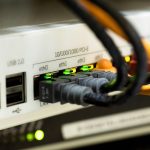USB hubs with LED indicators let you easily monitor your connections, ensuring you know exactly what's plugged in and what's not. These devices expand your computer's connectivity, allowing multiple peripherals to work simultaneously without shortages. The LED lights provide instant feedback and assist with troubleshooting, so you'll always stay informed about your setup. If you want to explore the best options available and tips to optimize your hub, keep going for more insights!
Table of Contents
Key Takeaways
- USB hubs with LED indicators provide instant feedback on device connection status, enhancing user experience and troubleshooting efficiency.
- Models like the Anker 10-Port and Sabrent 4-Port feature individual LEDs for monitoring active connections.
- Choose USB hubs that support USB 3.0 or higher for faster data transfer rates alongside LED indicators.
- LED indicators also help manage power consumption, preventing system overload and improving overall performance.
- Regularly check for firmware updates to ensure optimal functionality of your USB hub and its LED features.
Understanding USB Hubs and Their Functionality
USB hubs serve as essential devices that expand the connectivity options of your computer or laptop. They allow you to connect multiple USB devices, like keyboards, mice, and external drives, all at once.
With a USB hub, you don't have to worry about running out of ports, especially on devices with limited connections. When you plug in a hub, it communicates with your computer, ensuring data transfer between devices is seamless.
A USB hub eliminates port shortages, enabling seamless data transfer between multiple devices connected to your computer.
You'll find powered hubs that provide additional power to connected devices, ensuring they function optimally. Understanding the functionality of USB hubs helps you make informed choices when enhancing your setup, keeping your workspace organized and efficient.
They're a must-have for anyone relying on multiple peripherals.
The Advantages of LED Indicators
While using a USB hub, having LED indicators can significantly enhance your experience by providing real-time feedback on connection status.
These small lights offer several advantages that make your tasks easier:
- Instant Feedback: You can quickly see whether a device is connected or not, saving you time and frustration.
- Troubleshooting: If a device isn't working, the LED can help you identify if the connection is the issue.
- Power Management: Some hubs use LED indicators to show power usage, ensuring you don't overload your system.
- Visual Appeal: The added glow of LEDs can make your workspace look modern and organized.
With LED indicators, you'll enjoy a smoother, more efficient USB hub experience!
Choosing the Right USB Hub for Your Needs
Selecting the right hub can greatly impact your productivity and device management.
First, assess how many devices you'll connect. If you use multiple peripherals, opt for a hub with several ports. Think about the type of devices, too; some hubs support USB-C, while others are geared towards USB-A.
Speed matters, so look for USB 3.0 or higher for fast data transfers. Additionally, consider power delivery; if you need to charge devices, choose a hub with sufficient wattage.
Portability is another factor; if you travel often, a compact hub is more convenient. Lastly, check for LED indicators, as they help you monitor connections easily.
Top USB Hubs With LED Indicators on the Market
When you're in the market for a USB hub with LED indicators, you'll find a variety of models that cater to different needs.
Here are some top choices to consider:
Explore these top USB hubs with LED indicators to find the perfect fit for your connectivity needs!
- Anker 10-Port USB Hub – This hub offers multiple ports and individual LED indicators for each connection, making it easy to see what's active.
- Sabrent 4-Port USB Hub – Compact and efficient, it features bright LEDs that let you know when devices are connected.
- HooToo USB Hub – With a stylish design, it includes LED indicators that help you monitor your connections at a glance.
- AUKEY USB 3.0 Hub – This sturdy hub not only provides fast data transfer but also has clear LEDs for connection status.
Choose one that fits your needs!
Tips for Optimizing Your USB Hub Setup
To get the most out of your USB hub setup, prioritize organization and cable management. Keep your cables neatly arranged to avoid tangling and confusion. Use cable ties or clips to secure them in place, making it easier to identify connections.
Position your USB hub in a convenient location, close to your devices, to reduce cable length and clutter. Label your devices if you frequently switch them out; this will save you time when reconnecting.
Regularly check for firmware updates to ensure optimal performance and compatibility. Finally, consider using a powered USB hub if you connect multiple high-demand devices, as it provides adequate power without sacrificing performance.
These simple tips can enhance your experience and streamline your workflow.
Frequently Asked Questions
Can I Use a USB Hub With Different Device Types?
Yes, you can use a USB hub with different device types. Just make sure the hub supports the specific USB standards required by each device, and you'll enjoy seamless connectivity across your gadgets.
Do LED Indicators Consume Additional Power?
Yes, LED indicators do consume additional power, but it's usually minimal. When you connect your devices, those indicators help you monitor connections. Just keep in mind that they'll slightly affect your overall power usage.
How Do I Reset a Malfunctioning USB Hub?
To reset a malfunctioning USB hub, unplug it from the power source and disconnect all connected devices. Wait for about 30 seconds, then reconnect everything. This usually resolves temporary issues and restores normal functionality.
Are There USB Hubs With Wireless Connectivity Options?
Yes, there are USB hubs with wireless connectivity options. These hubs allow you to connect multiple devices without the clutter of cables, providing convenience and flexibility for your workspace or on-the-go setup.
What Cable Length Is Ideal for USB Hubs?
For USB hubs, an ideal cable length usually ranges from three to six feet. This length provides flexibility while maintaining signal integrity, ensuring you can connect your devices without compromising performance or convenience.




